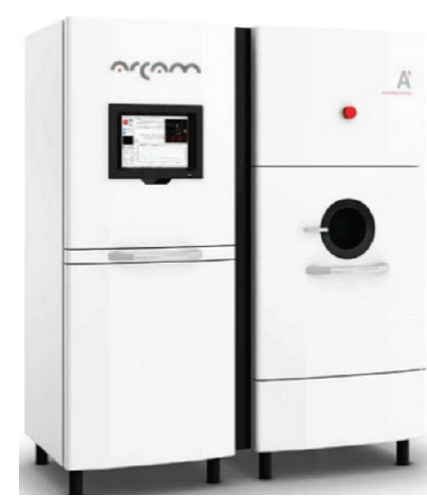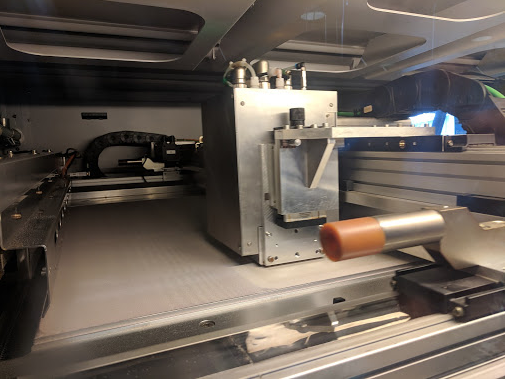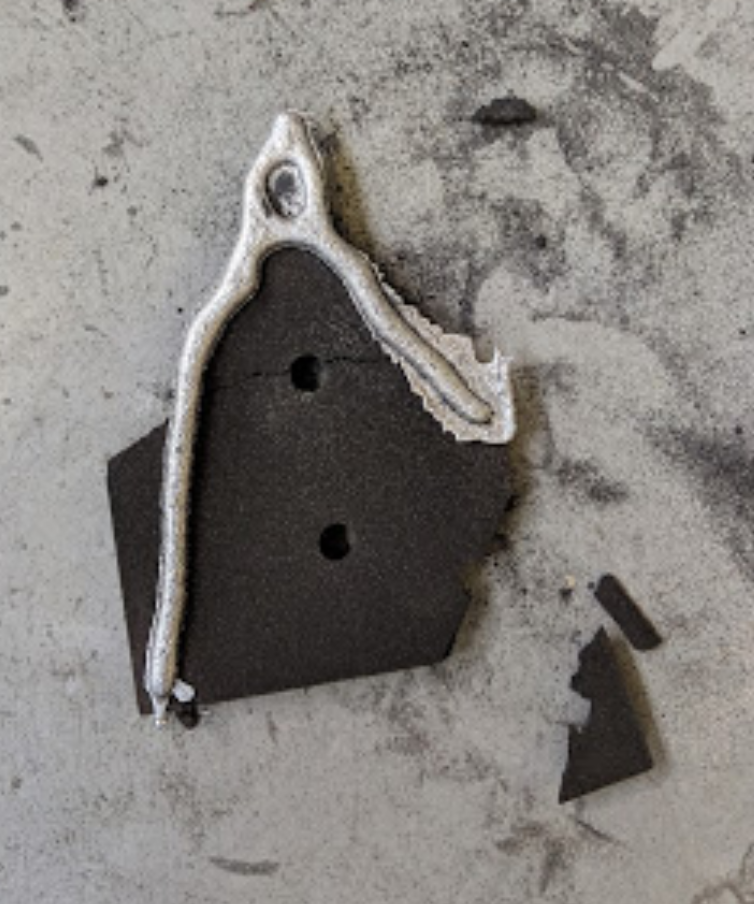‘Connectiveness’ – From concept to completion
From concept to completion each artwork has been created as one design. Each design includes the cast/printed object as one element and when connected with other elements – completes the design in its entirety under the ‘theme’ and its meaning – ‘Connectiveness’.
To consider the cast/printed metal object only is to denote the artwork/the cast/printed metal object to be one of ‘disconnectiveness’, not ‘connectiveness.
In this scenario, the cast/printed metal object signifies singularity, aloneness, abandonment.
In the context of my work this, in its manifestation in regard to being human, relates to issues of depression, suicide, loneliness … and, thus does not represent the very meaning/purpose of this Residency – ‘Connectiveness’.
The Team in Action
Since the last blog, work has progressed using two technologies:
- Voxeljet 3D sand printer
CAST ARTWORK DESIGNS
‘Neurons’
Aluminium
Inside the chamber where the sand printed moulds are created.
Carolynne learns – cleaning the mould to remove unbound sand, as it will impact adversely on the quality of the pour and/or the cast object.
Neuron cast in aluminium. Note the area around the end of the upper axon and in the central area ie the nucleus – where there is a gap between the upper and lower moulds, aluminium flows through and has to be removed by hand with tools such as pliers/Dremel and such, then the neuron polished. The black areas are the sand mould which is yet to be removed from the cast neuron.
- Arcam Electron Beam Melting 3D printer
3D PRINTED DESIGNS
‘Endoplasmic reticulum’ (rough and smooth)
Titanium

3D printing takes place within the Arcam.
The printing progress can be viewed through the round ‘black’ port.
Both technologies have presented challenges in transposing concepts into 3D objects that remain virtually the same as in my original 2D concept renderings.
Keeping the original concepts consistent with
the final object is testament to teamwork in action:
- CSIRO – Gary Savage (Voxeljet 3D sand printer) and Darren Fraser’s (Arcam Electron Beam Melting 3D printer) inputs into the CAD work, so as to enable the artwork designs to come to fruition (see previous blog).
- The work of Hasitha Bandara in taking ‘SolidWorks’ to its capacity in creating the CAD files that delivered my artwork designs.
Experimentation
There were inherent difficulties in being able to remain consistent to the original concept artwork designs taking into account the nature and attributes of mould making/casting and 3D printing. The 3D printing process on the ARCAM constitutes a different process and outcomes to that of the Voxeljet 3D sand printer. This is related to each specific technology and the selected metal for the particular artwork design.
At each stage, a forensic examination and assessment was required to identify problems that inhibited the original artwork design being created. Experimentation generated options, so as to determine the optimal solution for both the cast/printed objects and the elements that were required to complete each object.
An example, is the ‘Wallart’. It is in its entirety, the ‘Wallart’ piece is the interplay of the cast aluminium neurons within the display system in which they are placed. Considerations included, but are not exclusive to:
- Colour
- Texture
- Light
- Size, proportions
- Materials
- Cost
As a significant part of Residency, with all experiments, some solutions work, others do not and other directions pursued. In the instance of the ‘Wallart’ piece there has been many choices with respect to:
- The neurons
- Referencing photographs of actual neurons – Forms? Size?
- Transposing my 2D renderings into 3D CAD files. The intervening step between the aforementioned is gaining knowledge and understandings of the requirements that impact on casting and printing technologies – the mould and metal ie vents, temperature are but two aspects and for printed work.
• Determining – Quantity? Metal type? Finishing style. Surface – High or mat polish? Leave as cast/printed?
- Display system
- How to display the neurons as one artwork design?
Frame:
- Timber – Natural, stained or painted? Metal?
- Details eg Hanging/suspending/fixing the neurons – Screws? Nails? Staples? Wire? Thread?
- Dimension: Size of frame – weight, type, fixing neurons to/within the frame – Glue? Screw eye? Flat head screws?
- Background of the frame – include or not. If include what material – Type? Texture? Colour? Weight? Fixing to frame – Glue? Nail? Screw? Environmental issues ie maintenance/cleaning? – Humidity? Lighting?
…and these are but few considerations amongst many for just the one artwork design.
The Production Cycle – Experimentation. Testing. Assessing
Experimentation has been a key component of this Residency and has at all times been undertaken in collaboration with Team members as appropriate to the Problem in hand towards determining Options > Solutions.
Decision making has led me to options and then a final solutions.
Experimentation has been significant in two aspects:
1. Technical/engineering/CAD aspects related to casting and printing of the artwork designs.
At times, specialist engineering knowledge was required. This was provided with detail as needed to resolve the artwork design for printing/casting ie stability, strength, etc.
Conversations and mind maps such as the above were instrumental in solving the problem of the flow of metal between the two halves of the moulds – see example below where the aluminium is spurting out of the side of the mould and onto the floor. Weights were added to the top of the mould – see ingot shaped metal forms. However, if the vents were not placed appropriately or were too small in diameter the flow of metal was compromised.
The learning’s as to metal flow, temperature, venting and so forth has been highly informative and productive. Such problems have now been resolved with the CAD drawings been amended and the moulds held firmly in place re locators and weights to hold the moulds together.
2. In the main, each work required additional elements to complete it ie ‘Wallart refer to aforementioned.
Knowledge, Skill and Insight Transfer
Exchanges with CSIRO Team members were either informal ie in Lab22, in the hallway to discuss the topic/challenge in hand, or formally where meetings were diarised for a particular day/time/duration with one of more of the team attending.
Other team members are:
- Professor Ashley Bush
Chief Scientific Officer for the Cooperative
Research Centre for Mental Health (Parkville);
Professor of Neuroscience and Psychiatry
University of Melbourne;
Director of the new ‘Melbourne Dementia Research Centre’ (MDRC) which is a joint collaboration between the University
of Melbourne and The Florey Institute of Neuroscience and Mental Health.
Professor Bush and his team are kept informed as to the status of the project by emails and phone calls; as well I have:
> Meet with Professor Bush throughout the Residency to show and discuss the objects at each stage of their development.
> Had/having meetings with the ‘Melbourne Dementia
Research Centre’ staff plus emailed updates and spoken to
individuals at various touch points throughout the Residency.
- Industrial design student, Swinburne University of Technology.
In sitting alongside Hasitha Bandara for hours on end, I learnt much about CAD as I directed him in transforming my 2D work into CAD.
Work Sheets
Clear Communication between Team members
Work Sheets have been designed and implemented to ensure commonality of understandings re the design+technology where the ‘Problem’ was identified, ‘Options’ being proffered and ‘Solutions’ determined. An example of one Work Sheet – complexity such as precise measurements, positioning, colour, materials and so forth vary and are included in the sheets as appropriate:
Work Smart
I am continuing to ‘Work smart‘. Where possible, I am sourcing component parts for the artwork designs as required and appropriate.
The designs are artworks in progress with work continuing re final cleaning, finishing (polishing) of individual pieces and assembling with other elements to construct the final artwork design such as mounting the above neurons into a shadow box.
Expectations
Professional and personal expectations have been exceeded in:
- The selection of the theme being resolved into 3D metal objects.
- The technology available in Lab22 that has brought my concepts and theme to reality – what is invisible is now visible.
- The team that has supported me:
> ANAT – the management and administration staff of ANAT have provided information in a timely manner as queries arose during the course of undertaking the Residency ie the blog.
> CSIRO – the staff in Lab22 and those who organised access/parking. All were/are highly professional in their field of endeavour and welcoming during every phase of the Residency.
> Hasitha Bandara – the student who has worked diligently to complete the CAD files, at times into the midnight hours.
The Most Important Learning Experiences
- When human beings collaborate all things are possible – scientists and artwork designer working towards a common goal – outcome > printed and cast works.
- Transposing leading edge manufacturing technologies ie 3D printing into artwork designs.
- For this to happen we need ‘design’ to be understood as a ‘business tool’ in all industry sectors and occupations and that we all ‘design’, every day.
- Australia has amazing creative and technical talent, that when harnessed, can compete globally.
I bring into the Residency, my experience, qualifications, research and communications across diverse industries and disciplines which I meld together – art and design + technology + research + business + and in regard to this project, health – seeing my ideas and concepts come to life in three-dimensional works.
‘Connectiveness’: Micro to Macro
Being human
Around us we see beauty, but inside us – we are even more beautiful and we don’t know it.
Meaning = ‘Connectiveness’
It is a journey of meaning, of purpose, of connectiveness – to know the very stuff that is ‘you’, ‘me’, ‘them,’ ‘us’.
We are the same, yet miraculously different.
Seeing. Knowing. Learning
‘Connectiveness’ can be harnessed in developing ideas, finding new ways to think, new ways to work towards wellness in mind and body – live smarter.
… and most especially, in times of illness whether of the body or the mind regardless of age, socio-economic status, gender, religion or ethnicity ie the elderly or the homeless such as:
> Alzheimer’s Disease, Parkinson’s Disease
> Cancer
> Dementia
> Depression, suicide, abandonment. loneliness.
To dream and create ideas, determine solutions and take strategic risks and execute sound decisions… the brain can learn and change for each of us to become more than who we ever dreamed we
could be.
The Journey Continues…
The next stage is in taking the objects created in this Residency forward to the purpose for which they have been created is to bring that which is unseen in the human body and reveal it in the visible world with the purpose of knowing ourselves, changing ourselves and the environments in which we live, work, worship and play.





